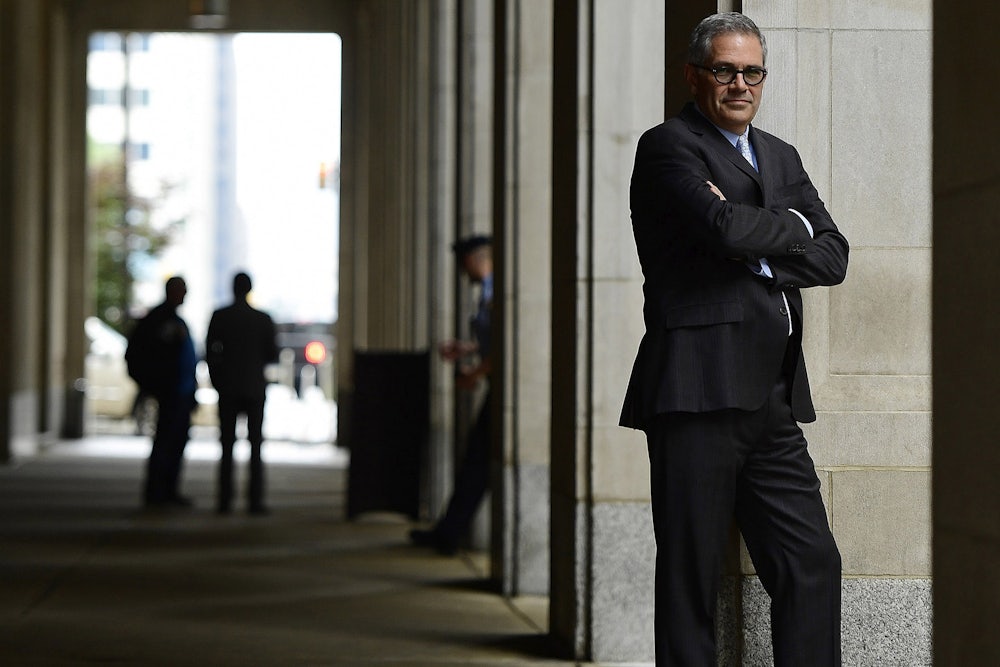Since his election last fall, Larry Krasner, Philadelphia’s district attorney, has been working to dismantle the prosecutorial practices that gave the city the highest incarceration rate of any major metropolitan area nationwide. In January, on his third day in office, Krasner dismissed 10 percent of Philadelphia’s career prosecutors, 31 in all. Then he told the ones who remained to stop requesting cash bail for minor infractions like marijuana possession or resisting arrest. He released more than 50 people charged with criminal marijuana possession. And in February, he announced a sweeping new drug policy: The police could still arrest residents for possession, he said at a press conference, but as long as they weren’t intending to sell the drugs, Krasner would no longer bring charges. (Offenders would be fined, not imprisoned.) Instead, he promised to steer prosecutors toward the ten big pharmaceutical companies that fuel drug addiction in the United States.
Philadelphia, where 72 percent of the city’s 7,000 prisoners are black, isn’t the only place where the public prosecutor is confronting race and over-incarceration. In 2016, George Soros, the philanthropist who’d later bankroll Krasner’s campaign, backed a dozen reform candidates, and ten of them won. Since then, cities such as Albuquerque, Denver, Houston, Jacksonville, and Tampa have all elected prosecutors interested in changing the system from within. (Mark Gonzalez, a prosecutor in Corpus Christi, Texas, even has the words NOT GUILTY tattooed on his chest.) This fall, a political action committee founded by journalist and activist Shaun King threw its support behind seven candidates across six counties in Texas and California. These are different campaigns, in different communities, but one thing they all have in common is a focus on how “prosecutorial discretion” can be used as a tool for reform.
U.S. prison population
2,162,400
1st in the world
Percentage of prisoners who are people of color
61
Estimated percentage of prosecutors who are people of color
5
Estimated percentage who are women of color
1
It’s a relatively new idea. For decades, reformers focused on changing America’s criminal justice system through its legislatures, a process that is vital but necessarily slow. Entrenched, powerful constituencies, like police unions and DA associations, can often slow legislation or stop it altogether. The California legislature, for example, took almost two decades to amend the notorious 1994 “three strikes” law, which required a 25-years-to-life sentence for a third felony conviction. This was despite the fact that just two years after its enactment, black people were receiving three strikes at 13 times the rate of whites. Today, with more than two million people languishing in America’s prisons and jails, at a cost to taxpayers of $87 billion per year, waiting for a legislature to act is not acceptable. Families with members suffering abuse in jail, job loss, and separation simply can’t afford to wait.
Starting in the 2000s, as incarceration rates in the United States doubled even though crime in its 30 biggest cities had dropped by half since 1991, a few reformist prosecutors emerged. In 2006, Craig Watkins, a black defense attorney in Dallas, was elected DA. At the time, Dallas had one of the highest rates of wrongful convictions in the United States, based on DNA evidence, so Watkins partnered with the Innocence Project of Texas to form one of the country’s first “Conviction Integrity Units,” a team of prosecutors who investigate past cases and look for wrongful convictions. Likewise, Ken Thompson, who became Brooklyn, New York’s first black DA in 2014, exonerated 21 people in the two years before he passed away.
Thompson and Watkins are, of course, something of an anomaly. America’s 2,400 prosecutors have long contributed to the high incarceration rates among people of color. A 2014 study conducted by the Vera Institute of Justice examined 200,000 cases brought by the Manhattan District Attorney’s office and found that prosecutors were more likely to ask judges to give black and Latino defendants jail time at their bail hearings and to offer them prison time rather than probation during plea bargaining. Professor Carlos Berdejó of Loyola Law School examined over 30,000 misdemeanor cases in Wisconsin and discovered that prosecutors were 74 percent more likely to drop, dismiss, or reduce all charges carrying potential prison time when a defendant was white. These aren’t isolated cases; even today, it’s systemic. And consider—95 percent of public prosecutors are white and only 1 percent are women of color.
But prosecutors also offer a powerful means of reform. Watkins’s approach, which he summed up as “I lock them up if they’re guilty,” has spread around the country. Few public prosecutors’ offices had CIU divisions when he took office; today, there are 33 nationwide, and the number of exonerations has risen, too—from 68 in 2008, the year Watkins established Dallas’s CIU, to 171 in 2016. In Brooklyn, Thompson helped drive a national debate on ending low-level marijuana arrests, which inordinately harm young people of color, to focus on violent crimes. His decision in 2014 to refuse to prosecute low-level marijuana offenses forced the NYPD to reconsider its drug arrest policies and stands as an example of how the influence of a prosecutor, used appropriately, can extend beyond the courtroom.
